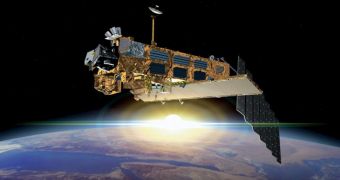In a recent maneuver, the Envisat satellite has been moved to a lower orbit around the Earth. This move will conserve fuel, and will extend spacecraft operations by as much as three years.
Envisat, built, launched and operated by the European Space Agency (ESA), has been providing the international scientific community with invaluable data for the past 8 years.
The satellite carries with it a complex suite of 10 scientific instruments, which can collect information about Earth's atmosphere, land, sea and ice covers.
In other words, it is capable of producing a nearly-complete image of the planet all on its own. Its data sets have thus far been used in a large number of research papers, as well as in practical applications.
Officials at ESA decided to lower Envisat's orbit in order to ensure that the spacecraft will remain operational for a lot longer than its planned life span.
When launched, the satellite was planned to remain in orbit until 2007. Its mission was then extended until 2010, but the space agency persuaded Member States to continue funding the mission until 2013.
ESA representatives say that this was very easy to do even under the current financial climate, because of the excellent state in which the satellite remained, after all these years of operations.
The plan to lower its orbit was developed by experts in the Netherlands, at the ESA European Space Research and Technology Center (ESTEC) in Noordwijk.
The lowering maneuver took two 28-minute repositioning moves to perform, and dropped Envisat from an altitude of 800 kilometers to 783 kilometers. The satellite weighs more than 8 tons, and was moved on the morning of October 22 (10 kilometers), and then on October 27 (7 kilometers).
Just one day later, all of the instruments were brought back online, says Henri Laur, who is the Envisat mission manager at ESA. He adds that the satellite is now resuming normal activity patterns.
“The first images acquired from the new altitude confirm that the satellite is in good health and that the maneuvers have been successful,” the official explains.
“The teams are now very busy running intensive checks on Envisat’s space and ground systems,” he says. The extended phase of the mission is called Envisat 2010+.

 14 DAY TRIAL //
14 DAY TRIAL //